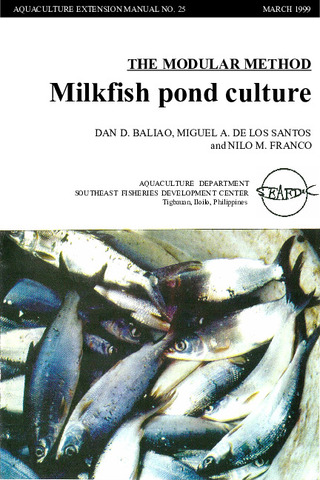Egg cannibalism by milkfish (Chanos chanos Forsskal) spawners in circular floating net cages
- Global styles
- MLA
- Vancouver
- Elsevier - Harvard
- APA
- Help
Share
Abstract
Egg cannibalism by milkfish spawners in a circular floating net cage was investigated. The cage was lined with a fine mesh hapa net to retain spawned eggs and to prevent the entry of fish egg predators. Water samples were collected from the surface (0 m), middle (1.5 m), and bottom (3.0 m) of a 10 m diameter by 3 m deep floating net cage at the time of initial detection of spawning (0 min) and at 30, 60, 120 and 240 min thereafter. The mean number of spawned eggs at the surface significantly decreased (P<0.05) 60 min after spawning and very few eggs were recovered 240 min later. There was no significant difference (P>0.05) in the mean number of spawned eggs collected from the middle and bottom of the net cage at various times after spawning. Eggs were found in the digestive tract of all milkfish sampled (n=6) at about 5 h after spawning, indicating that captive milkfish eat their own eggs. It is recommended that spontaneously spawned milkfish eggs should be collected immediately after spawning to avoid loss by egg cannibalism.
Suggested Citation
Toledo, J. D., & Gaitan, A. G. (1992). Egg cannibalism by milkfish (Chanos chanos Forsskal) spawners in circular floating net cages. Journal of Applied Ichthyology , 8(1-4), 257-262. https://doi.org/10.1111/j.1439-0426.1992.tb00692.x
Type
ArticleISSN
0175-8659Collections
- Journal Articles [1258]
Related items
Showing items related by title, author, creator and subject.
-
Series: Aquaculture extension manual; No. 25
The modular method: Milkfish pond culture
Baliao, Dan D.; de los Santos, Miguel A.; Franco, Nilo M. (Aquaculture Department, Southeast Asian Fisheries Development Center, 1999)The modular method of milkfish culture (Chanos chanos) described in the manual is an improvement over the traditional extensive method. The manual is intended for the use of fish farmers and aquaculturists, extensionists, ... -
Evaluation of organic and inorganic fertilizers in brackishwater milkfish ponds
Bombeo-Tuburan, Isidra; Agbayani, Renato F.; Subosa, Precilla F. (Elsevier, 1989)The study was conducted in twelve 144-m2 ponds to evaluate the effect of different organic and inorganic fertilizers on the growth, survival, gross production, and profitability of marketable milkfish. The ... -
Milkfish breeding and hatchery technology at SEAFDEC/AQD
Unknown author (Aquaculture Department, Southeast Asian Fisheries Development Center, 1999)Describes the techniques already adopted by the private sector: broodstock management, broodstock diet, commercial fry production, live transport, and larval diet. A list of AQD research publications on milkfish is included.






